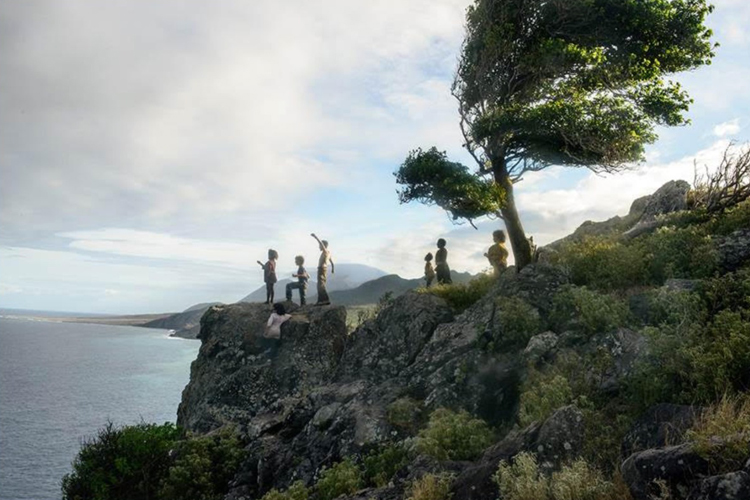If film critics aren’t careful, we can fall victim to a sensation colloquially known as “festival brain”. The hype-soaked atmosphere of a film festival can make critics more willing to overlook a movie’s flaws, which eventually builds into an unspoken peer pressure: other critics, upon seeing their festival-brained colleagues overpraise a movie, will second-guess their less charitable views of the film and adjust their thoughts accordingly (sometimes unconsciously). That’s the only way I can rationalize the reception of Beasts of the Southern Wild, a vacuous and vaguely racist indie that many critics fell head over heels for in 2012. I won’t rehash the arguments against it here—activist and scholar bell hooks already wrote a definitive take on the film titled “No Love in the Wild”—but I will hash out my problems with Wendy, a (new!) vacuous and vaguely racist indie from the director of Beasts of the Southern Wild.
Wendy, directed by Benh Zeitlin and written by Ben and his sister Eliza, is a reimagining of the classic tale of Peter Pan. (It was acquired by Fox Searchlight before Disney bought the studio, but it’s being released by the Disney subsidiary in 2020, so is it technically one of their live-action remakes now? Who cares!) Wendy is a young girl who’s fed up with life on the Louisiana bayou and dreams of going on a grand adventure. One night, after she sees a boy on top of a moving train, she and her twin brothers hop out their bedroom window to join the mysterious child, who leads them to the modern Neverland: an island of magical black kids.
Ah yes, racism, a timeless part of the Peter Pan story. Where the original play and the Disney animation were overtly prejudiced against Native Americans (maybe children shouldn’t be raised on songs like “What Makes the Red Man Red?”), Wendy dabbles in a more insidious prejudice, the kind of covert racism that was evident in Beasts of the Southern Wild. There are children both black and white in Wendy’s Neverland, but only the black kids have an unexplained, intrinsic connection to the land that grants them magical powers. It is with these powers that Neverland’s black citizens—none of whom are protagonists, despite one being Peter Pan—gain the trust of the white protagonists and help them along a journey of self-discovery. This is, almost beat for beat, the “Magical Negro” trope: a storytelling device that positions black people as something other than standard humans and subordinates their existence to a white person’s narrative arc. It’s an old, racist trope, and it’s especially disappointing to see in a movie aimed at children.
Wendy’s “Magical Negro” problem is nowhere near as pervasive, however, as Beasts of the Southern Wild’s “noble savage” problem—it’s more of a nagging issue than a central thesis of the movie. The most generous read of Wendy (which is not necessarily the most realistic one) is that its racism is an accidental byproduct of its underwritten characters. From a script perspective, none of the children are gifted at the “being human” thing. They’re blank slates, devoid of character traits save for their defining ones; platitude mouthpieces who make decisions with unimaginable rationale. Newcomers to the island become privy to its supernatural rules in a matter of minutes—eliminating what otherwise would’ve been a sense of wonder—and start spouting lines like “when the first child laughed for the very first time, the sound broke into millions of glowing pieces” while talking to an enchanted fish. It’s not that deep.
Zeitlin’s talent as a director of child actors, though, lends the movie a spirit that its other elements lack. Beasts of the Southern Wild was most valuable for its performance from Quvenzhané Wallis, the youngest actress ever nominated for an Academy Award, and Wendy ups its predecessor with a smattering of small artists. Devin France, the 12-year-old who portrays the titular Wendy, focuses a seriousness in her eyes that seasoned actors would be jealous of. And a real sort of magic is made by the kids’ physicality: they elude the camera like endlessly contorting energy reserves, barely contained on the screen or in upright positions. The surrogate youthfulness they generate can be spellbinding.
Wendy starts falling into the Disney-esque trap of declaring growing up the ultimate evil—at one point, an adult character laments that they no longer “have imagination”—but it recovers with uncharacteristic maturity, even if its symbols for infantilism sacrifice clarity for artiness (that enchanted fish? It’s a spiritual-mother-fish.) There are two moments in which the clouds part and the movie finds meaning in its characters, and one of them is the second-to-last shot—but it’s followed by a final shot so opaque and lifeless that it reminds you what the rest of the movie was like. What a shame.
★★ (2/5)




